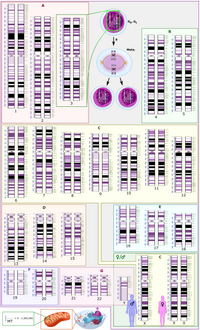
Photo from wikipedia
Background Consanguineous families have a relatively high prevalence of genetic disorders caused by bi-allelic mutations in recessive genes. This study aims to evaluate the effectiveness and efficiency of a consanguinity-based… Click to show full abstract
Background Consanguineous families have a relatively high prevalence of genetic disorders caused by bi-allelic mutations in recessive genes. This study aims to evaluate the effectiveness and efficiency of a consanguinity-based exome sequencing approach to capturing genetic mutations in inherited retinal dystrophy families with consanguineous marriages. Methods Ten unrelated consanguineous families with a proband affected by inherited retinal dystrophy were recruited in this study. All participants underwent comprehensive ophthalmic examinations. Whole exome sequencing was performed, followed by a homozygote-prior strategy to rapidly filter disease-causing mutations. Bioinformatic prediction of pathogenicity, Sanger sequencing and co-segregation analysis were carried out for further validation. Results In ten consanguineous families, a total of 10 homozygous mutations in 8 IRD genes were identified, including 2 novel mutations, c.1654_1655delAG (p. R552Afs*5) in gene FAM161A in a patient diagnosed with retinitis pigmentosa, and c.830T > C (p.L277P) in gene CEP78 in a patient diagnosed with cone and rod dystrophy. Conclusion The genetic etiology in consanguineous families with IRD were successfully identified using consanguinity-based analysis of exome sequencing data, suggesting that this approach could provide complementary insights into genetic diagnoses in consanguineous families with variant genetic disorders.
Journal Title: Orphanet Journal of Rare Diseases
Year Published: 2021
Link to full text (if available)
Share on Social Media: Sign Up to like & get
recommendations!